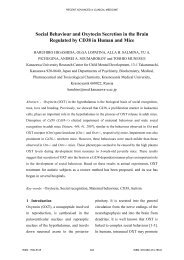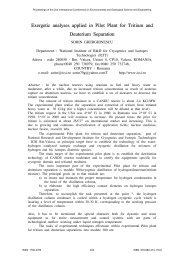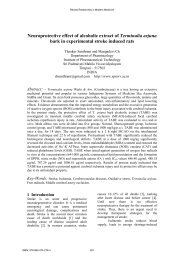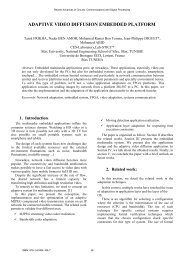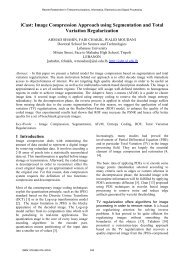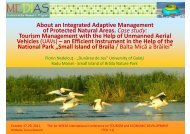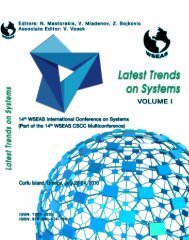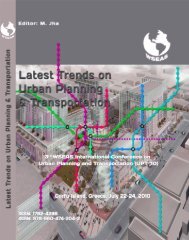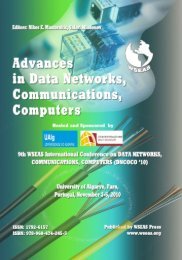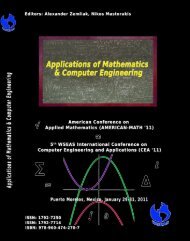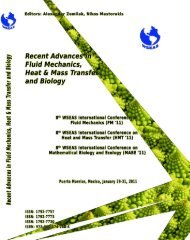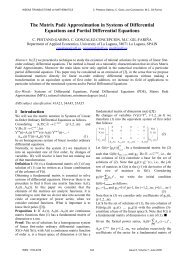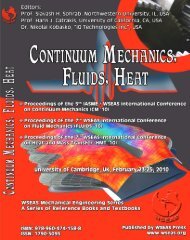Applied Mathematics in Electrical and Computer ... - Wseas.us
Applied Mathematics in Electrical and Computer ... - Wseas.us
Applied Mathematics in Electrical and Computer ... - Wseas.us
- No tags were found...
Create successful ePaper yourself
Turn your PDF publications into a flip-book with our unique Google optimized e-Paper software.
APPLIED MATHEMATICS <strong>in</strong>ELECTRICAL <strong>and</strong> COMPUTERENGINEERINGProceed<strong>in</strong>gs of the AMERICAN CONFERENCE on APPLIEDMATHEMATICS (AMERICAN-MATH '12)Proceed<strong>in</strong>gs of the 6th WSEAS International Conference onCIRCUITS, SYSTEMS, SIGNAL <strong>and</strong> TELECOMMUNICATIONS(CSST '12)Proceed<strong>in</strong>gs of the 6th WSEAS International Conference onCOMPUTER ENGINEERING <strong>and</strong> APPLICATIONS (CEA '12)Harvard, Cambridge, USAJanuary 25-27, 2012Published by WSEAS Press ISBN: 978-1-61804-064-0HTUwww.wseas.orgUT
APPLIED MATHEMATICS <strong>in</strong>ELECTRICAL <strong>and</strong> COMPUTERENGINEERINGProceed<strong>in</strong>gs of the AMERICAN CONFERENCE on APPLIEDMATHEMATICS (AMERICAN-MATH '12)Proceed<strong>in</strong>gs of the 6th WSEAS International Conference onCIRCUITS, SYSTEMS, SIGNAL <strong>and</strong> TELECOMMUNICATIONS(CSST '12)Proceed<strong>in</strong>gs of the 6th WSEAS International Conference onCOMPUTER ENGINEERING <strong>and</strong> APPLICATIONS (CEA '12)Harvard, Cambridge, USAJanuary 25-27, 2012Published by WSEAS Presswww.wseas.orgCopyright © 2012, by WSEAS PressAll the copyright of the present book belongs to the World Scientific <strong>and</strong> Eng<strong>in</strong>eer<strong>in</strong>g Academy <strong>and</strong>Society Press. All rights reserved. No part of this publication may be reproduced, stored <strong>in</strong> a retrievalsystem, or transmitted <strong>in</strong> any form or by any means, electronic, mechanical, photocopy<strong>in</strong>g, record<strong>in</strong>g, orotherwise, without the prior written permission of the Editor of World Scientific <strong>and</strong> Eng<strong>in</strong>eer<strong>in</strong>g Academy<strong>and</strong> Society Press.All papers of the present volume were peer reviewed by no less that two <strong>in</strong>dependent reviewers.Acceptance was granted when both reviewers' recommendations were positive.See also: http://www.worldses.org/review/<strong>in</strong>dex.htmlISBN: 978-1-61804-064-0World Scientific <strong>and</strong> Eng<strong>in</strong>eer<strong>in</strong>g Academy <strong>and</strong> Society
APPLIED MATHEMATICS <strong>in</strong>ELECTRICAL <strong>and</strong> COMPUTERENGINEERINGProceed<strong>in</strong>gs of the AMERICAN CONFERENCE on APPLIEDMATHEMATICS (AMERICAN-MATH '12)Proceed<strong>in</strong>gs of the 6th WSEAS International Conference onCIRCUITS, SYSTEMS, SIGNAL <strong>and</strong> TELECOMMUNICATIONS(CSST '12)Proceed<strong>in</strong>gs of the 6th WSEAS International Conference onCOMPUTER ENGINEERING <strong>and</strong> APPLICATIONS (CEA '12)Harvard, Cambridge, USAJanuary 25-27, 2012
Editors:Professor Manoj K. Jha, Morgan State University, USAProfessor Myriam Lazard, Institut Superieur d’Ingenierie de la Conception, FranceProfessor Azami Zaharim, Universiti Kebangsaan Malaysia, MalaysiaProfessor Kamaruzzaman Sopian, Universiti Kebangsaan Malaysia, MalaysiaInternational Scientific Committee:Ahmed Boutejdar, GermanyOlga Mart<strong>in</strong>, RomaniaPanos Pardalos, USAKabir Mashud, GermanyRonald Yager, USAAmauri Caballero, USANikos Mastorakis, BulgariaMueller Soeren, GermanyGeorge Vachtsevanos, USARobert F<strong>in</strong>kel, USADemetrios Kazakos, USAZhiqiang Gao, USACayrel P-Louis, GermanyYan Wu, USASpyros Tragoudas, USAArkady Kholodenko, USAGregory Baker, USATheodore Trafalis, USATakis Kasparis, USAGaligekere Dattatreya, USACarol<strong>in</strong>e Sweezy, USAAsad Salem, USADian Zhou, USAThimm Heiko, GermanyDaowen Qiu, Ch<strong>in</strong>aMet<strong>in</strong> Demiralp, TurkeyKleanthis Psarris, USAAndrew D. Jones, USAValeri Mladenov, BulgariaNeri F., ItalyChen S. Y., P. R. Ch<strong>in</strong>aShyi-M<strong>in</strong>g Chen, R. O. C.Yen K., USARong-Jyue Fang, TaiwanArgyrios Varonides, USANikolai Kobasko, USAXu Anp<strong>in</strong>g, P. R. Ch<strong>in</strong>aZhu H., JapanJoseph Sifakis, FranceLotfi A. Zadeh, USALeon O. Chua, USAK. R. Rao, USADimitri Bertsekas, USABiswa N. Datta, USAIrw<strong>in</strong> S<strong>and</strong>berg, USAA. Manikas, UkT. Kaczorek, Pol<strong>and</strong>Wlodzislaw Duch, Pol<strong>and</strong>Sidney Burr<strong>us</strong>, USALeonid G. Kazovsky, USAGeorgios B. Giannakis, USANikolaos G. Bourbakis, USABrian A. Barsky, USARyszard S. Choras, Pol<strong>and</strong>Wasfy B. Mikhael, USAM. Kostic, USAA. Venetsanopoulos, CanadaK. Benra, GermanyS. Sohrab, USA
PrefaceThis year the AMERICAN CONFERENCE on APPLIED MATHEMATICS (AMERICAN-MATH '12), the 6th WSEAS International Conference on CIRCUITS, SYSTEMS, SIGNAL <strong>and</strong>TELECOMMUNICATIONS (CSST '12) <strong>and</strong> the 6th WSEAS International Conference onCOMPUTER ENGINEERING <strong>and</strong> APPLICATIONS (CEA '12) were held <strong>in</strong> Harvard,Cambridge, USA. The conferences provided a platform to disc<strong>us</strong>s l<strong>in</strong>ear algebra, numericalanalysis, differential equations, probabilities, statistics, operational research, optimization,algorithms, discrete mathematics, computers, circuits, systems, signal process<strong>in</strong>g,telecommunications, networks etc. with participants from all over the world, both from academia<strong>and</strong> from <strong>in</strong>d<strong>us</strong>try.Their success is reflected <strong>in</strong> the papers received, with participants com<strong>in</strong>g from several countries,allow<strong>in</strong>g a real mult<strong>in</strong>ational multicultural exchange of experiences <strong>and</strong> ideas.The accepted papers of these conferences are published <strong>in</strong> this Book that will be <strong>in</strong>dexed by ISI.Please, check it: www.worldses.org/<strong>in</strong>dexes as well as <strong>in</strong> the CD-ROM Proceed<strong>in</strong>gs. They willbe also available <strong>in</strong> the E-Library of the WSEAS. The best papers will be also promoted <strong>in</strong> manyJournals for further evaluation.Conferences such as these can only succeed as a team effort, so the Editors want to thank theInternational Scientific Committee <strong>and</strong> the Reviewers for their excellent work <strong>in</strong> review<strong>in</strong>g thepapers as well as their <strong>in</strong>valuable <strong>in</strong>put <strong>and</strong> advice.The Editors
<strong>Applied</strong> <strong>Mathematics</strong> <strong>in</strong> <strong>Electrical</strong> <strong>and</strong> <strong>Computer</strong> Eng<strong>in</strong>eer<strong>in</strong>gTable of ContentsPlenary Lecture 1: Market Efficiency <strong>and</strong> Behavioral F<strong>in</strong>ance: A Unify<strong>in</strong>g Stochastic Model ofStock PricesSergio BianchiPlenary Lecture 2: Convergence Speed <strong>and</strong> Population Dynamics <strong>in</strong> the AK Model with HabitFormationMassimiliano Ferrara1517Plenary Lecture 3: Swarm Intelligence Algorithms Parameter Tun<strong>in</strong>g 19Milan TubaPlenary Lecture 4: A Possible Solution of Trisection Problem 20Siavash H. SohrabPlenary Lecture 5: M<strong>in</strong>imal surfaces <strong>and</strong> their controlled evolution 21Constant<strong>in</strong> UdristePlenary Lecture 6: Optimal FIR Estimation of Analog Quantities <strong>in</strong> Discrete-Time State Space 22Yuriy S. ShmaliyPlenary Lecture 7: Specific role <strong>and</strong> position<strong>in</strong>g of the telecommunications solution <strong>in</strong> theIntelligent Transport SystemsTomas Zel<strong>in</strong>kaPlenary Lecture 8: Investigat<strong>in</strong>g the Viability of Hybrid <strong>and</strong> Electric Automobiles byUnderst<strong>and</strong><strong>in</strong>g the Influence of Road Design, Traffic Congestion, <strong>and</strong> Driver Behavior on VehiclePower UsesManoj K. Jha2324Plenary Lecture 9: Non-traditional Approach to <strong>Computer</strong> Energy Reduction 25Vasily G. MoshnyagaPlenary Lecture 10: Comb<strong>in</strong><strong>in</strong>g Virtual <strong>and</strong> Augmented Reality to Improve the MechanicalAssembly Tra<strong>in</strong><strong>in</strong>g Process <strong>in</strong> Manufactur<strong>in</strong>gAmaury Andres Peniche GonzalezPlenary Lecture 11: Create a Self-Model<strong>in</strong>g DSS <strong>in</strong> the Cloud: Perspectives, Methodologies <strong>and</strong>Case StudiesRoberto Revetria2627Plenary Lecture 12: A Long-Term Information Service for Professional Development 28Lung-Hs<strong>in</strong>g KuoModel<strong>in</strong>g Gap Acceptance <strong>and</strong> Driver Behavior at Stop Controlled (Priority) Intersections <strong>in</strong>Develop<strong>in</strong>g CountriesRene Lord-Attivor, Manoj K. Jha29Navigation Assistance <strong>and</strong> Lane Detection Us<strong>in</strong>g the Topology Wavefront Strategy 39Clayton G. Thomas Jr., Manoj K. JhaISBN: 978-1-61804-064-0 9
<strong>Applied</strong> <strong>Mathematics</strong> <strong>in</strong> <strong>Electrical</strong> <strong>and</strong> <strong>Computer</strong> Eng<strong>in</strong>eer<strong>in</strong>gTransit Service Indicators for Alternative Route Structure Analysis 45Timothy F. Welch, Sabyasachee Mishra, Manoj K. JhaAssembly Flowshop Schedul<strong>in</strong>g Problem to M<strong>in</strong>imize Total Tard<strong>in</strong>ess 51Ali Allahverdi, Harun AydilekThe Converg<strong>in</strong>g Under-Damped Harmonic Growth of Prime Numbers 54Ernest G. HibbsA Simple Heuristic to F<strong>in</strong>d Efficiently k-Nearest Neighbors <strong>in</strong> Flock<strong>in</strong>g Behaviors 60Jae Moon Lee, Hye-Kyung ChoManufactur<strong>in</strong>g <strong>and</strong> Shipment Policy Mak<strong>in</strong>g for an Integrated System with Rework <strong>and</strong> a CostLessen<strong>in</strong>g Product Delivery PlanS<strong>in</strong>ga Wang Chiu, Kuang-Ku Chen, Yuan-Shyi Peter Chiu, Sh<strong>in</strong>-Wei Chen, M<strong>in</strong>g-Syuan SongAlternative Approach for Manufactur<strong>in</strong>g <strong>and</strong> Shipment Policy Mak<strong>in</strong>g for a System withRework <strong>and</strong> a Cost Lessen<strong>in</strong>g Product Delivery PlanYuan-Shyi Peter Chiu, S<strong>in</strong>ga Wang Chiu, Chih-Kai Chang, Chiu-Yen Shen6571Seismic Wave <strong>in</strong> Magnetoelastic Irregular Anisotropic Layer 77Amares Chattopadhyay, Sanjeev A. SahuMonotonicity of NFP Mapp<strong>in</strong>gs Associated with Variational Inequality <strong>and</strong> Its Application 83Hemant Kumar PathakOn a General Formula for Comput<strong>in</strong>g the One-Dimensional Differential Transform of Nonl<strong>in</strong>earFunctions <strong>and</strong> Its ApplicationsAbdelhalim Ebaid92W<strong>in</strong>d Speed Model<strong>in</strong>g <strong>and</strong> Prediction <strong>in</strong> W<strong>in</strong>d Farms Us<strong>in</strong>g Fuzzy Logic 98Shahram Javadi, Ze<strong>in</strong>ab Hojjat<strong>in</strong>iaOn Experiments Taken by the Active Shock Absorber Test St<strong>and</strong> 104Kater<strong>in</strong>a Hyniova, Ladislava Smitkova-Janku, Jaroslav Honcu, Anton<strong>in</strong> StribrskyAn Efficient Approach to Speed up the Search Process dur<strong>in</strong>g Fractal Match<strong>in</strong>g Process 110Hsiao-Wen T<strong>in</strong>, Shao-Wei Leu, Shun-Hsyun Chang2D Text Visualization for the Retrieval of Malay Documents 116Normaly Kamal Ismail, Tengku Mohd Tengku SembokPosition Function <strong>in</strong> <strong>Mathematics</strong> 122Claude Ziad Bayeh, Nikos E. MastorakisAdvanced Model<strong>in</strong>g Methodology Based on System Dynamics <strong>in</strong> Healthcare 127Revetria R., Mosca R., Cassetari L., Guizzi G., Romano E., Santillo L. C.Compar<strong>in</strong>g Image Classification Methods: K-Nearest-Neighbor <strong>and</strong> Support-Vector-Mach<strong>in</strong>es 133J<strong>in</strong>ho Kim, Byung-Soo Kim, Silvio SavareseISBN: 978-1-61804-064-0 10
<strong>Applied</strong> <strong>Mathematics</strong> <strong>in</strong> <strong>Electrical</strong> <strong>and</strong> <strong>Computer</strong> Eng<strong>in</strong>eer<strong>in</strong>gDiverse Factorial Operators 139Claude Ziad Bayeh, Nikos E. MastorakisBounded Solutions of a Fifth Order Model Equation for Steady Capillary-Gravity Waves over aBump with the Bond Number Near 1/3Chung-Hsien Tsai, Shy-Jen Guo145Snubber Circuit Designed for Electric Car Drive System 149Sakrawee RaweekulOpposition Product <strong>in</strong> <strong>Mathematics</strong> 153Claude Ziad Bayeh, Nikos E. MastorakisNumerical Solution of Two-Po<strong>in</strong>t Boundary Value Problems Us<strong>in</strong>g S<strong>in</strong>c Interpolation 157Kenzu AbdellaEffect of First- <strong>and</strong> Second-Order Extensions on UFIR Filter<strong>in</strong>g of Nonl<strong>in</strong>ear Models 163Felipe Ramirez-Echeverria, Jose Contreras-Gonzalez, Yuriy S. ShmaliyEfficient Denois<strong>in</strong>g of Piecewise-Smooth Signals with Forward-Backward FIR Smoothers 169Osbaldo Vite-Chavez, Roberto Olivera-Reyna, Jorge Munoz-M<strong>in</strong>jares, Yuriy S. Shmaliy, Oscar Ibarra-Manzano, Luis Morales-MendozaAn Analysis of Errors <strong>in</strong> RFID SAW-Tag Systems with Pulse Position Cod<strong>in</strong>g 175Yuriy S. Shmaliy, G<strong>us</strong>tavo Cerda-Villafana, Oscar Ibarra-Manzano, Victor PlesskyApplication of a Park<strong>in</strong>g Enforcement System Us<strong>in</strong>g Smartphones 181Doyeon Kim, Choonki Song, Jaejoon KimSelf-Adjo<strong>in</strong>tness <strong>and</strong> Conservation Laws for a New Integrable Equation 187Maria Luz G<strong>and</strong>arias, Maria Santos BruzonAn Object Track<strong>in</strong>g System for PTZ Cameras Us<strong>in</strong>g CAM Shift 191Sang Gu Lee, Ji Hoon JoS<strong>in</strong>e Dot Product 195Claude Ziad Bayeh, Nikos E. MastorakisA Mathematical Model for the Quantitative Analysis of Law. Putt<strong>in</strong>g Legal Values <strong>in</strong>to Numbers 201Massimiliano Ferrara, Angelo Roberto GagliotiMathematical Modell<strong>in</strong>g of Brown Seaweed Dry<strong>in</strong>g Curves 207Ahmad Fudholi, Mohd Hafidz R<strong>us</strong>lan, Lim Ch<strong>in</strong> Haw, Sohif Mat, Mohd Y<strong>us</strong>of Othman, Azami Zaharim,Kamaruzzaman SopianAn Algorithm to Implement a Fluoroscopic Stereo System Us<strong>in</strong>g a S<strong>in</strong>gle Simulated Fluoroscope<strong>and</strong> an Optical NavigatorMario Donnici, Michele Perrelli, Paola Nudo, Guido Danieli212Educational Software <strong>in</strong> WEB – Based Teach<strong>in</strong>g 217Danimir M<strong>and</strong>ic, Danijela Krasic-Kostad<strong>in</strong>ovicISBN: 978-1-61804-064-0 11
<strong>Applied</strong> <strong>Mathematics</strong> <strong>in</strong> <strong>Electrical</strong> <strong>and</strong> <strong>Computer</strong> Eng<strong>in</strong>eer<strong>in</strong>gDecision Support System <strong>in</strong> Modern Education 222Danimir M<strong>and</strong>ic, Nada Vilotijevic, Ivko NikolicApplication of <strong>Computer</strong> Algebra Approach to Solve Eng<strong>in</strong>eer<strong>in</strong>g Problems - A Case Study:Power Supply Stabilization Loop CircuitTamiyo Nakabayashi, Keiji Nakabayashi, Fujio Kako228Improvement of Supply Cha<strong>in</strong> Efficiency with a <strong>Computer</strong> Learn<strong>in</strong>g Game 234Ken Dozier, David ChangThe Probabilistic Model of R<strong>and</strong>om Variation <strong>in</strong> Nanoscale MOSFET’s High FrequencyPerformanceRawid Banchu<strong>in</strong>Techno-Economics Analysis of a W<strong>in</strong>d/PV Hybrid System to Provide Electricity for a Ho<strong>us</strong>ehold<strong>in</strong> MalaysiaAhmad Fudholi, Mohd Zamri Ibrahim, Mohd Hafidz R<strong>us</strong>lan, Lim Ch<strong>in</strong> Haw, Sohif Mat,Mohd Y<strong>us</strong>ofOthman, Azami Zaharim, Kamaruzzaman Sopian240246The Applications Us<strong>in</strong>g Data Envelopment Analysis 251Tasho Tashev, Asya AngelovaDesign of Replicated Real-time Database Simulator 254Hala Abdel Hameed, Hazem M. El-Bakry, Torky SultanImprov<strong>in</strong>g Drill<strong>in</strong>g Operations Management Us<strong>in</strong>g Comb<strong>in</strong>ed Simulation 263Revetria R., Testa A., Cassetari L., Guizzi G., Romano E., Gallo M.Comb<strong>in</strong>ed Simulation for improv<strong>in</strong>g Operations <strong>in</strong> LNG Logistics: A Case Study 271Giribone P., Guizzi G., Mur<strong>in</strong>o T.,Romano E., Revetria R., Testa A.A Possible Solution of Trisection Problem 277Siavash H. SohrabFPGA Based IR Code Recognizer 286Alghamdi Ali S., Kenaya Riyadh L.Comb<strong>in</strong><strong>in</strong>g Virtual <strong>and</strong> Augmented Reality to Improve the Mechanical Assembly Tra<strong>in</strong><strong>in</strong>gProcess <strong>in</strong> Manufactur<strong>in</strong>gAmaury Peniche, Christian Diaz, Helmuth Trefftz, Gabriel ParamoMeasurement of Rasch Analysis towards Requirement Eng<strong>in</strong>eer<strong>in</strong>g Education: Ind<strong>us</strong>tryPerspectiveNor Azliana Akmal Jamalud<strong>in</strong>, Shamsul Sahibudd<strong>in</strong>A Fundamental Frequency Extraction Method Based on W<strong>in</strong>dowless <strong>and</strong> NormalizedAutocorrelation FunctionsM. A. F. M. Rashidul Hasan, Tetsuya Shimamura292298305WEB Portals for Support<strong>in</strong>g Relations between Physical Condition <strong>and</strong> Learn<strong>in</strong>g Abilities 310Danimir M<strong>and</strong>ic, Danica Dz<strong>in</strong>ovic, Dragan Mart<strong>in</strong>ovicISBN: 978-1-61804-064-0 12
<strong>Applied</strong> <strong>Mathematics</strong> <strong>in</strong> <strong>Electrical</strong> <strong>and</strong> <strong>Computer</strong> Eng<strong>in</strong>eer<strong>in</strong>gSpecific Telecommunications Solutions for ITS Applications 315Tomas Zel<strong>in</strong>ka, Miroslav Svitek, Zdenek LokajAdvanced Model of Intelligent Transport Systems 323Miroslav Svitek, Tomas Zel<strong>in</strong>ka, Michal JerabekImprov<strong>in</strong>g the Prediction Accuracy of Liver Disorder Disease with Oversampl<strong>in</strong>g 331Hyontai SugReal Time Schedul<strong>in</strong>g Verification with Incomplete Information 336Maurizio Talamo, Andrea Callia D’Iddio, Christian H. Schunck, Franco ArcieriMathematical <strong>and</strong> Virtual Model for Mechanical Structures with Free Connect<strong>in</strong>g Rod 345Elena Mereuta, Marian Tudoran, Daniel Ganea, Claudiu MereutaLocal Estimation of Stock Market Efficiency 349Sergio Bianchi, Alex<strong>and</strong>re Pantanella, Aug<strong>us</strong>to PianeseEvaluation of Local Content Strategies to Plan Large Eng<strong>in</strong>eer<strong>in</strong>g Projects <strong>in</strong> the Oil & GasInd<strong>us</strong>try <strong>in</strong> High Risk Country AreasDe Falco Massimo, Gallo Mose, Santillo Liberat<strong>in</strong>a Carmela, Troncone Enzo Piermichele, PierAlberto Viecelli356Self-Adjo<strong>in</strong>tness <strong>and</strong> Conservation Laws for a Benjam<strong>in</strong>-Bona-Mahony Equation 363Maria S. Bruzon, Maria L. G<strong>and</strong>ariasAnalysis of Dem<strong>and</strong> Variability <strong>in</strong> a Kanban Cell by Virtual Kanban Strategy 366Cassettari L., Gallo M., Montella D. R., Revetria R., Romano E., Testa A.A World Class Manufactur<strong>in</strong>g Implementation Model 371Mur<strong>in</strong>o T., Naviglio G., Romano E., Guerra L., Revetria R., Mosca R., Cassettari L. C.On Integer Sequences Derived from Balanced k-ary Trees 377Sung-Hyuk ChaSchedul<strong>in</strong>g Activity Based on Hybrid Manufactur<strong>in</strong>g Systems 382Chiocca D., Guizzi G., Naviglio G., Iuliano A., Revetria R., Mosca R., Cassettari L. C.Swarm Intelligence Algorithms Parameter Tun<strong>in</strong>g 389Milan TubaModified Seeker Optimization Algorithm for Unconstra<strong>in</strong>ed Optimization Problems 395Ivona Brajevic, Milan TubaOn an Elementary Proof for a Class of Elliptic Over-Determ<strong>in</strong>ed Problems <strong>in</strong> a DoublyConnected Doma<strong>in</strong>Lakhdar Ragoub401Artificial Fish Swarm Algorithm for Unconstra<strong>in</strong>ed Optimization Problems 405Nebojsa Bacan<strong>in</strong>, Milan Tuba, Nadezda StanarevicISBN: 978-1-61804-064-0 13
<strong>Applied</strong> <strong>Mathematics</strong> <strong>in</strong> <strong>Electrical</strong> <strong>and</strong> <strong>Computer</strong> Eng<strong>in</strong>eer<strong>in</strong>gAn Object-Oriented Implementation of the Firefly Algorithm for Cont<strong>in</strong>uo<strong>us</strong> Unconstra<strong>in</strong>edOptimization ProblemsMilos Subotic, Ivan Misic, Milan Tuba411Software Framework for Test<strong>in</strong>g JPEG Quantization Tables for Iris Recognition 417Ana Tuba, Jovo Arez<strong>in</strong>a, Raka JovanovicModified Approximation Method for Identification of Nonl<strong>in</strong>ear Systems Us<strong>in</strong>g Volterra Models<strong>in</strong> Frequency Doma<strong>in</strong>Vitaliy Pavlenko, Viktor Speranskyy, Vladimir Ily<strong>in</strong>, Vladimir Lomovoy423On Design <strong>and</strong> Control of Oscillation Us<strong>in</strong>g Limit Cycles 429Hassan Fathabadi, Nikos E. MastorakisEffective Use of Technology Can Improve the Quality <strong>and</strong> Productivity of Mach<strong>in</strong><strong>in</strong>g Operationof Fuze ShopShafqat Hameed, Muhammad Abid Abbas, Irfan Ghalib436Authors Index 446ISBN: 978-1-61804-064-0 14
<strong>Applied</strong> <strong>Mathematics</strong> <strong>in</strong> <strong>Electrical</strong> <strong>and</strong> <strong>Computer</strong> Eng<strong>in</strong>eer<strong>in</strong>gPlenary Lecture 1Market Efficiency <strong>and</strong> Behavioral F<strong>in</strong>ance: A Unify<strong>in</strong>g Stochastic Model of Stock PricesProfessor Sergio BianchiRector's Delegate for Research <strong>and</strong> Benchmark<strong>in</strong>gFaculty of Economics - University of Cass<strong>in</strong>oVia S. Angelo, Camp<strong>us</strong> Folcara - 03043 CASSINO (FR)ITALYE-mails: sbianchi@eco.unicas.itAbstract: Reams <strong>and</strong> reams have been written <strong>in</strong> quantitative f<strong>in</strong>ance about the unsolved problem of the stockmarkets efficiency. Start<strong>in</strong>g from the sem<strong>in</strong>al work of Fama (1970), who def<strong>in</strong>ed the Efficient Market Hypothesis <strong>in</strong>terms of expected values conditional to the <strong>in</strong>formative set ("f<strong>in</strong>ancial assets fully reflect all available <strong>in</strong>formation thatis relevant to their values"), a huge number of works have tried to address the question whether real f<strong>in</strong>ancial marketsbehave efficiently. Roughly speak<strong>in</strong>g, the EMH argues that market does price assets broadly correctly, exclud<strong>in</strong>g thatdeviations from equilibrium values could last for long. So great was the consens<strong>us</strong> met by the EMH to set one of themost impressive bodies of knowledge of the 20th century: the mathematical f<strong>in</strong>ance.Nonetheless, the number of equilibrium theorems proved under the assumptions of the EMH grew at the same rate ofthe empirical evidence that made questionable the validity of the EMH itself.Many approaches have been followed <strong>in</strong> literature to test the EMH. In spite of all the efforts, to date the problemrema<strong>in</strong>s open <strong>and</strong> current more than ever, basically beca<strong>us</strong>e of two ma<strong>in</strong> reasons:- the analyses, particularly those aim<strong>in</strong>g at test<strong>in</strong>g the r<strong>and</strong>om walk model <strong>in</strong> its different specifications, often providenon concl<strong>us</strong>ive results;- the real world dynamics, with their repeated f<strong>in</strong>ancial crises made of bubbles <strong>and</strong> crashes, serio<strong>us</strong>ly do challengethe credibility of the EMH, to the extent that a str<strong>and</strong> of skeptical thought, the behavioural f<strong>in</strong>ance, has been boom<strong>in</strong>g.One of the most quoted works <strong>in</strong> this context is due to DeBondt <strong>and</strong> Thaler (1985); they show that <strong>us</strong><strong>in</strong>g historicalreturns abnormal profits are achievable <strong>in</strong> the long-run, simply go<strong>in</strong>g short a portfolio of 'w<strong>in</strong>ner stocks' (i.e., stockswith good performances <strong>in</strong> the past) <strong>and</strong> go<strong>in</strong>g long a portfolio of 'loser stocks' (i.e., stocks that performed badly <strong>in</strong> thepast). What ca<strong>us</strong>es these opposite profits, accord<strong>in</strong>g to the authors, is <strong>in</strong>vestors' excess of optimism <strong>and</strong> pessimism,the so called overreaction to <strong>in</strong>formation. Follow<strong>in</strong>g this analysis, a plethora of contributions provided evidence ofreverse abnormal profits <strong>and</strong> documented them <strong>in</strong> <strong>in</strong>ternational markets <strong>and</strong> for short time horizons. Other empiricalresults suggest that prices underreact to <strong>in</strong>formation <strong>in</strong> a way to generate the so called the "momentum" profit; thetrad<strong>in</strong>g strategy <strong>in</strong> this case consists <strong>in</strong> go<strong>in</strong>g long a portfolio of extremely w<strong>in</strong>ner stocks <strong>in</strong> the past <strong>and</strong> go<strong>in</strong>g short aportfolio of extremely loser stocks.Results like those j<strong>us</strong>t recalled raise the question whether a model exists able to make consistent all these oppositef<strong>in</strong>d<strong>in</strong>gs. The paper concludes <strong>in</strong> favour of an affirmative answer: a model is disc<strong>us</strong>sed that, recently def<strong>in</strong>ed byAyache <strong>and</strong> Taqqu (2005) <strong>in</strong> a general sett<strong>in</strong>g, succeeds <strong>in</strong> reconcil<strong>in</strong>g efficiency <strong>and</strong> behavioural f<strong>in</strong>ance. Themodel, named Multifractional Processes with R<strong>and</strong>om Exponent (MPRE), emanates from the well-known fractionalBrownian motion (fBm), the unique Ga<strong>us</strong>sian process, self-similar of order H, vanish<strong>in</strong>g at the orig<strong>in</strong> with stationary<strong>in</strong>crements, <strong>in</strong>troduced to model long-range dependence. The parameter H of the fBm is <strong>in</strong>formative of the <strong>in</strong>tensityof dependence <strong>and</strong> of the regularity of the process' paths. Yet, the constancy of H is undesirable for manyphenomena, whose complexity requires the po<strong>in</strong>twise regularity to change over time, even abruptly. When H isreplaced by a r<strong>and</strong>om function one gets the MPRE. The construction of this class of processes considers (a) aGa<strong>us</strong>sian field depend<strong>in</strong>g on H <strong>and</strong> the time doma<strong>in</strong>, <strong>and</strong> (b) a r<strong>and</strong>om variable or a stochastic process with values <strong>in</strong>an arbitrary fixed compact <strong>in</strong>terval. The result<strong>in</strong>g process is versatile enough to describe very complex phenomenasuch as stock price dynamics..Brief Biography of the Speaker: Sergio Bianchi, born on 25 September 1967, graduated <strong>in</strong> 1991 from University ofCass<strong>in</strong>o (Italy) <strong>in</strong> Economics. He earned his Ph.D. <strong>in</strong> Actuarial Science from University of Rome "La Sapienza" (Italy).After teach<strong>in</strong>g experiences as <strong>in</strong>vited professor at the Pontifical Gregorian University (Vatican State) <strong>and</strong> at Universityof Sassari (Italy), <strong>in</strong> 1998 was appo<strong>in</strong>ted assistant professor at University of Cass<strong>in</strong>o, where became associateprofessor <strong>in</strong> 2001 <strong>and</strong> full professor of <strong>Mathematics</strong> <strong>and</strong> F<strong>in</strong>ancial <strong>Mathematics</strong> <strong>in</strong> 2006. S<strong>in</strong>ce 2003 to 2005 he wasscientific responsible for the <strong>Computer</strong> Laboratory of the Department "Economia e Territorio" at University of Cass<strong>in</strong>o.ISBN: 978-1-61804-064-0 15
<strong>Applied</strong> <strong>Mathematics</strong> <strong>in</strong> <strong>Electrical</strong> <strong>and</strong> <strong>Computer</strong> Eng<strong>in</strong>eer<strong>in</strong>gHe also held the office of Head of the Department "Istituzioni, Metodi Quantitativi e Territorio" from 2005 to 2009,when he resigned after the appo<strong>in</strong>tment as Rector's Delegate for Research <strong>and</strong> Benchmark<strong>in</strong>g. Member of the boardof professors of the Ph.D. <strong>in</strong> Economics at the same University, he is referee for a number of <strong>in</strong>ternational journals<strong>and</strong> the author of more than fifty research papers concern<strong>in</strong>g the model<strong>in</strong>g of f<strong>in</strong>ancial time series by (multi)fractionalprocesses <strong>and</strong> self-similar stochastic processes.ISBN: 978-1-61804-064-0 16
<strong>Applied</strong> <strong>Mathematics</strong> <strong>in</strong> <strong>Electrical</strong> <strong>and</strong> <strong>Computer</strong> Eng<strong>in</strong>eer<strong>in</strong>gPlenary Lecture 2Convergence Speed <strong>and</strong> Population Dynamics <strong>in</strong> the AK Model with Habit FormationProfessor Massimiliano FerraraDepartment SSGESMediterranean University of Reggio CalabriaVia dei Bianchi, 2, Reggio Calabria, 89127ITALYE-mail: massimiliano.ferrara@unirc.itAbstract: AK-type models with habit formation have been <strong>us</strong>ed <strong>in</strong> the literature to address a wide variety of issues.For example, through numerical simulations, Carroll et al have shown that the <strong>in</strong>troduction of habit formation <strong>in</strong> thest<strong>and</strong>ard AK endogeno<strong>us</strong> growth model may ca<strong>us</strong>e this model to exhibit transitional dynamics, while Gomez hasproved that the convergence speed of the AK model with external habits is higher than that <strong>in</strong> the AK model with<strong>in</strong>ternal habits. It is known that <strong>us</strong>ually st<strong>and</strong>ard economic growth theory assumes that labor (population) force growsat a positive constant rate (Malth<strong>us</strong>ian model). However, this assumption is not a good approximation to reality aspopulation exponentially grows without limits, which is clearly unrealistic. To remove the prediction of unboundedpopulation size <strong>in</strong> the very long-run, Verhulst wrote an alternative model, known as the logistic growth model, wherethe population stock evolves accord<strong>in</strong>g to an elongated S-curve. Recent forecasts (e.g., United Nations) confirm thatthe annual growth rate of population is expected to fall gradually until 2100, <strong>and</strong> that world population will stabilize ata level of about eleven billion people by 2200. Th<strong>us</strong>, not only theoretically but also empirically, it seems reasonable tomodel population size as follow<strong>in</strong>g a logistic process. Bucci <strong>and</strong> Guerr<strong>in</strong>i, Ferrara <strong>and</strong> Guerr<strong>in</strong>i, Germana’ <strong>and</strong>Guerr<strong>in</strong>i, <strong>and</strong> Guerr<strong>in</strong>i, have recently explored the implications of study<strong>in</strong>g some economic growth models with<strong>in</strong> aframework where the change over time of the labor force is non constant but governed by the logistic law or by abounded population growth rate. In this paper, we wish to <strong>in</strong>vestigate the dynamic effects of assum<strong>in</strong>g a logisticpopulation growth hypothesis <strong>in</strong> Gomez’s model. This set-up leads the economy to be described by a fourdimensional dynamical system, whose unique non-trivial steady state equilibrium is a saddle po<strong>in</strong>t with a twodimensional stable manifold. Two stable roots, rather than only one as <strong>in</strong> Gomez, determ<strong>in</strong>e the speed ofconvergence. Now, the crucial determ<strong>in</strong>ant of the asymptotic speed of convergence is the larger of the two negativeeigenvalues. As a result, contrary to Gomez, the asymptotic speed of convergence may be not necessarilydecreas<strong>in</strong>g as the value of some parameter <strong>in</strong>creases.Brief Biography of the Speaker: Massimiliano Ferrara is Associate Professor of Mathematical Economics at"Mediterranea" University of Reggio Calabria where he was also Dean of the degree <strong>in</strong> Economics (2007-2010).Actually he is the Director of Department - Culture, Education, Research <strong>and</strong> University at Regione Calabria. He wasthe Founder <strong>and</strong> Director of MEDAlics (2009) – Research Centre for Mediterranean Studies - <strong>and</strong> Vice Rector at"Dante Alighieri" University of Reggio Calabria. He was also Visit<strong>in</strong>g Professor at Morgan State University <strong>in</strong>Baltimore (USA), Western Michigan University (USA), New Jersey Institute of Technology <strong>in</strong> Newark (NJ) (USA).Heis co-author of the research work on "Knowledge flows <strong>and</strong> technological trajectories <strong>in</strong> the Mediterranean Area"published <strong>in</strong> 2009 on African Journal of Science, Technology, Innovation <strong>and</strong> Development, <strong>and</strong> for volume"Economics <strong>and</strong> International Cooperation <strong>in</strong> the Mediterranean Area" for Rubbett<strong>in</strong>o Editore. Invited Speaker byWSEAS Conferences (Baltimora MACMESE '09 Morgan State University) by American Mathematical Society(Western Michigan University, USA) <strong>and</strong> Calcutta Mathematical Society, INDIA <strong>and</strong> Visit<strong>in</strong>g Professor at theLomonosov Moscow State University (Department of <strong>Mathematics</strong>), at the New Jersey Institute of Technology <strong>in</strong>NewArk (NJ) (USA), (Department of Mathematical Sciences), at the Eotvos Lor<strong>and</strong> University of Budapest(Department of Atomic Physics, Faculty of Sciences), at Politehnica of Bucharest (Department of <strong>Mathematics</strong>).Author of 105 publications on <strong>in</strong>ternational journals many of them "high impact Scientific International (ISI)" <strong>and</strong> 5monographs. Member of Indian Academy of <strong>Mathematics</strong> (2008- current), Member of Accademia Peloritana deiPericolanti (2003-current), Member of the Balkan Society of Geometers (2003- current), Member of AMASES -Associazione di Matematica Applicata alle Scienze Economiche e Sociali - (2003- current), Member of the ScientificSET - Advances Center for Studies on Economic Theory - (Center for Advanced Studies Theoretical Economics) atthe University of Milan Bicocca (2005-current), Member of the Mathematical Association of America (2007-current),Member of the SIEP (Societa italiana di Economia Pubblica) (2008-current). Scientific Coord<strong>in</strong>ator of <strong>in</strong>ternationalISBN: 978-1-61804-064-0 17
<strong>Applied</strong> <strong>Mathematics</strong> <strong>in</strong> <strong>Electrical</strong> <strong>and</strong> <strong>Computer</strong> Eng<strong>in</strong>eer<strong>in</strong>gprojects f<strong>in</strong>anced by the M<strong>in</strong>istry of Foreign Affairs:the Executive Programme of scientific <strong>and</strong> techonologicalcooperation between Italy <strong>and</strong> Romania dur<strong>in</strong>g 2006- 2008 <strong>and</strong> of the Executive Programme of scientific <strong>and</strong>technological cooperation between Italy <strong>and</strong> Estonia dur<strong>in</strong>g 2005-2007. Editor <strong>and</strong> referree of several InternationalJournals. Official Reviewer of Mathematical Reviews (MathSciNet), Division of the American Mathematical Society<strong>and</strong> Zentralblatt MATH, reviews scientific journal published by the European Mathematical Society, the HeidelbergAcademy of Sciences <strong>and</strong> Fach<strong>in</strong>formationszentrum Karlshruhe. His ma<strong>in</strong> research <strong>in</strong>terests are: dynamical systems,patterns of growth <strong>and</strong> s<strong>us</strong>ta<strong>in</strong>able development, mathematical economics, game theory, optimization theory, appliedEconomics.ISBN: 978-1-61804-064-0 18
<strong>Applied</strong> <strong>Mathematics</strong> <strong>in</strong> <strong>Electrical</strong> <strong>and</strong> <strong>Computer</strong> Eng<strong>in</strong>eer<strong>in</strong>gPlenary Lecture 3Swarm Intelligence Algorithms Parameter Tun<strong>in</strong>gProfessor Milan TubaUniversity Megatrend BelgradeFaculty of <strong>Computer</strong> ScienceSerbiaE-mail: tuba@ieee.orgAbstract: Most real-life problems can be represented as some k<strong>in</strong>d of optimization problem. Easy optimizationproblems were solved long time ago so nowadays only hard problems are of research <strong>in</strong>terest. Many discrete(comb<strong>in</strong>atorial) as well as some cont<strong>in</strong>uo<strong>us</strong> optimization problems are <strong>in</strong>tractable, but of great practical <strong>in</strong>terest.Travel<strong>in</strong>g salesman problem (TSP) is a classic example that was researched for the longest period of time <strong>and</strong>beca<strong>us</strong>e of that is often <strong>us</strong>ed as a benchmark.The ma<strong>in</strong> problem with hard optimization problems is that there is enormo<strong>us</strong> number of suboptimal solutions or localm<strong>in</strong>ima <strong>and</strong> there is no guidance how to search. St<strong>and</strong>ard down-hill methods <strong>in</strong> this situation fail. Typical example ofsuch function that is <strong>us</strong>ed as a benchmark is Rastrig<strong>in</strong> function that is a sphere modified by small cos<strong>in</strong>e waves.The oldest way to deal with such problems is Monte-Carlo method. It is equivalent of try<strong>in</strong>g to f<strong>in</strong>d the deepest po<strong>in</strong>t<strong>in</strong> the oceans by measur<strong>in</strong>g many times the depth at r<strong>and</strong>om locations <strong>and</strong> hop<strong>in</strong>g that best measurement will beclose to the global optimum. While Monte-Carlo method is <strong>us</strong>able for some applications, its bl<strong>in</strong>d search is notsufficient for many others. In this rather hopeless situation researchers turned from mathematically exact methods tobelief. The nature is do<strong>in</strong>g miraculo<strong>us</strong> th<strong>in</strong>gs. We know the results but we do not underst<strong>and</strong> the mechanism. Forhard optimization problems we try to mimic some nature processes. Older attempts <strong>in</strong>cluded simulation of evolution(through genetic modifications <strong>and</strong> survival of the fittest) <strong>and</strong> simulated anneal<strong>in</strong>g. Recently, swarm <strong>in</strong>telligencebecome prom<strong>in</strong>ent <strong>us</strong><strong>in</strong>g the fact that extremely simple <strong>in</strong>dividuals exhibit miraculo<strong>us</strong> collective <strong>in</strong>telligence.Examples <strong>in</strong>clude ants colonies, honey bees colonies, flocks of birds, schools of fish etc.These nature <strong>in</strong>spired metaheuristics simulate vario<strong>us</strong> natural phenomena. We talk about bee colony food f<strong>in</strong>d<strong>in</strong>g orant colony path f<strong>in</strong>d<strong>in</strong>g, but <strong>in</strong> essence, <strong>in</strong> all these diverse mimick<strong>in</strong>g we do two th<strong>in</strong>gs. We exploit good foundsolutions, but also go to unknown places <strong>in</strong> order to avoid be<strong>in</strong>g trapped <strong>in</strong> local m<strong>in</strong>ima. The successfulness of anysuch algorithm is determ<strong>in</strong>ed by proper balance between exploitation <strong>and</strong> exploration. This balance is ma<strong>in</strong>ta<strong>in</strong>ed byadj<strong>us</strong>t<strong>in</strong>g certa<strong>in</strong> parameters <strong>and</strong> also by apply<strong>in</strong>g some rules <strong>in</strong> certa<strong>in</strong> situations. By do<strong>in</strong>g such adj<strong>us</strong>tmentsalgorithm can become much better for some class of problems (off course, accord<strong>in</strong>g to NFL theorem, it cannotbecome universally good for all problems). This plenary lecture will demonstrate few successful examples of suchadj<strong>us</strong>tments.Brief Biography of the Speaker: Milan Tuba received B. S. <strong>in</strong> <strong>Mathematics</strong>, M. S. <strong>in</strong> <strong>Mathematics</strong>, M. S. <strong>in</strong><strong>Computer</strong> Science, M. Ph. <strong>in</strong> <strong>Computer</strong> Science, Ph. D. <strong>in</strong> <strong>Computer</strong> Science from University of Belgrade <strong>and</strong> NewYork University. From 1983 to 1994 he was <strong>in</strong> the U.S.A. first as a graduate student <strong>and</strong> teach<strong>in</strong>g <strong>and</strong> researchassistant at V<strong>and</strong>erbilt University <strong>in</strong> Nashville <strong>and</strong> Courant Institute of Mathematical Sciences, New York University<strong>and</strong> later as an Assistant Professor of <strong>Electrical</strong> Eng<strong>in</strong>eer<strong>in</strong>g at Cooper Union Graduate School of Eng<strong>in</strong>eer<strong>in</strong>g, NewYork. Dur<strong>in</strong>g that time he was the founder <strong>and</strong> director of Microprocessor Lab <strong>and</strong> VLSI Lab, leader of scientificprojects <strong>and</strong> supervisor of many theses. From 1994 he was Assistant professor of <strong>Computer</strong> Science <strong>and</strong> Director of<strong>Computer</strong> Center at University of Belgrade, from 2001 Associate Professor, Faculty of <strong>Mathematics</strong>, <strong>and</strong> from 2004also a Professor of <strong>Computer</strong> Science <strong>and</strong> Dean of the College of <strong>Computer</strong> Science, Megatrend UniversityBelgrade. He was teach<strong>in</strong>g more than 20 graduate <strong>and</strong> undergraduate courses, from VLSI Design <strong>and</strong> <strong>Computer</strong>Architecture to <strong>Computer</strong> Networks, Operat<strong>in</strong>g Systems, Image Process<strong>in</strong>g, Calcul<strong>us</strong> <strong>and</strong> Queu<strong>in</strong>g Theory. Hisresearch <strong>in</strong>terest <strong>in</strong>cludes mathematical, queu<strong>in</strong>g theory <strong>and</strong> heuristic optimizations applied to computer networks,image process<strong>in</strong>g <strong>and</strong> comb<strong>in</strong>atorial problems. He is the author of more than 130 scientific papers <strong>and</strong> a monograph.He is coeditor or member of the editorial board or scientific committee of number of scientific journals <strong>and</strong>conferences. Member of the ACM s<strong>in</strong>ce 1983, IEEE 1984, New York Academy of Sciences 1987, AMS 1995, SIAM2009. Participated <strong>in</strong> many WSEAS Conferences with plenary lectures <strong>and</strong> articles <strong>in</strong> Proceed<strong>in</strong>gs <strong>and</strong> Transactions.ISBN: 978-1-61804-064-0 19
<strong>Applied</strong> <strong>Mathematics</strong> <strong>in</strong> <strong>Electrical</strong> <strong>and</strong> <strong>Computer</strong> Eng<strong>in</strong>eer<strong>in</strong>gPlenary Lecture 4A Possible Solution of Trisection ProblemProfessor Siavash H. SohrabRobert McCormick School of Eng<strong>in</strong>eer<strong>in</strong>g <strong>and</strong> <strong>Applied</strong> ScienceDepartment of Mechanical Eng<strong>in</strong>eer<strong>in</strong>gNorthwestern University, Evanston, Ill<strong>in</strong>oisUSAE-mail: s-sohrab@northwestern.eduAbstract: A solution of the ancient Greek problem of trisection of an arbitrary angle employ<strong>in</strong>g only compass <strong>and</strong>straightedge <strong>and</strong> its algebraic proof are presented. It is shown that while Wantzel’s theory of 1837 concern<strong>in</strong>girreducibility of the cubic x 3 -3x-1=0 is correct it does not imply impossibility of trisection of arbitrary angle s<strong>in</strong>ce ratherthan a cubic equation the trisection problem is shown to depend on the quadratic equation y 2 -3+c=0 where c is aconstant. The earlier formulation of the problem by Descartes the father of algebraic geometry is also disc<strong>us</strong>sed. Ifone assumes that the ruler <strong>and</strong> the compass employed <strong>in</strong> the geometric constructions are <strong>in</strong> fact Platonic ideal<strong>in</strong>struments then the trisection solution proposed here<strong>in</strong> should be exact.Brief Biography of the Speaker: Siavash H. Sohrab received his PhD <strong>in</strong> Eng<strong>in</strong>eer<strong>in</strong>g Physics <strong>in</strong> 1981 fromUniversity of California, San Diego, his MS degree <strong>in</strong> Mechanical Eng<strong>in</strong>eer<strong>in</strong>g from San Jose State University <strong>in</strong>1975, <strong>and</strong> his BS degree <strong>in</strong> Mechanical Eng<strong>in</strong>eer<strong>in</strong>g from the University of California, Davis <strong>in</strong> 1973. He then jo<strong>in</strong>edNorthwestern University <strong>in</strong> 1982 as postdoctoral research assistant <strong>and</strong> became Visit<strong>in</strong>g Assistant Professor <strong>in</strong> 1983,Assistant Professor of Mechanical Eng<strong>in</strong>eer<strong>in</strong>g <strong>in</strong> 1984, <strong>and</strong> s<strong>in</strong>ce 1990 he is Associate Professor of MechanicalEng<strong>in</strong>eer<strong>in</strong>g at the Northwestern University. From 1975-1978 he worked as a scientist do<strong>in</strong>g research on fireprotection <strong>and</strong> turbulent comb<strong>us</strong>tion at NASA Ames research center <strong>in</strong> California. His research <strong>in</strong>terests have beenon comb<strong>us</strong>tion, fluid dynamics, thermodynamics, <strong>and</strong> statistical <strong>and</strong> quantum mechanics.ISBN: 978-1-61804-064-0 20
<strong>Applied</strong> <strong>Mathematics</strong> <strong>in</strong> <strong>Electrical</strong> <strong>and</strong> <strong>Computer</strong> Eng<strong>in</strong>eer<strong>in</strong>gPlenary Lecture 5M<strong>in</strong>imal surfaces <strong>and</strong> their controlled evolutionProf. Dr. Constant<strong>in</strong> UdristeUniversity Politehnica of BucharestFaculty of <strong>Applied</strong> SciencesDepartment of <strong>Mathematics</strong>-InformaticsRomaniaE-mail: udriste@mathem.pub.roAbstract: The theory of smallest area surfaces evolv<strong>in</strong>g with unit areal speed is a particular case of the theory ofsurfaces of m<strong>in</strong>imum area subject to vario<strong>us</strong> constra<strong>in</strong>ts. Based on our recent results, such problems can be solved<strong>us</strong><strong>in</strong>g the two-time maximum pr<strong>in</strong>ciple <strong>in</strong> a controlled evolution.Section 1 studies a controlled dynamics problem (smallest area surface evolv<strong>in</strong>g with unit areal speed) via the twotimemaximum pr<strong>in</strong>ciple. The evolution PDE is of 2-flow type <strong>and</strong> the adjo<strong>in</strong>t PDE is of divergence type. Section 2analyzes the smallest area surfaces evolv<strong>in</strong>g with unit areal speed, avoid<strong>in</strong>g an obstacle. Section 3 reconsiders thesame problem for touch<strong>in</strong>g an obstacle, detail<strong>in</strong>g the results for the cyl<strong>in</strong>der <strong>and</strong> the sphere.Brief Biography of the Speaker: Important Career Positions: Professor Consultant, Dean, Director, Chair, FullProfessor 1990-2011, University Politehnica of Bucharest, Department of <strong>Mathematics</strong>-Informatics.Number of PhD Students: 28 <strong>in</strong> due time <strong>and</strong> 19 Doctors <strong>in</strong> <strong>Mathematics</strong>.Membership of Associations: AMS, 1987; Tensor Society, 1985; Balkan Society of Geometers, President, 1994;Publications: over 45 books; 275 papers; 275 communications..ISBN: 978-1-61804-064-0 21
<strong>Applied</strong> <strong>Mathematics</strong> <strong>in</strong> <strong>Electrical</strong> <strong>and</strong> <strong>Computer</strong> Eng<strong>in</strong>eer<strong>in</strong>gPlenary Lecture 6Optimal FIR Estimation of Analog Quantities <strong>in</strong> Discrete-Time State SpaceProfessor Yuriy S. ShmaliyDepartment of ElectronicsDICIS, Guanajuato UniversitySalamanca, 36855, MexicoE-mail: shmaliy@salamanca.ugto.mxAbstract: Measurement is always provided with analog sensors, whereas process<strong>in</strong>g <strong>and</strong> estimation is typicallyobta<strong>in</strong>ed <strong>us</strong><strong>in</strong>g DSP power. This lecture exam<strong>in</strong>es the problem of optimal filter<strong>in</strong>g, <strong>in</strong>terpolation, <strong>and</strong> extrapolation ofdynamic analog quantities exist<strong>in</strong>g <strong>in</strong> cont<strong>in</strong>uo<strong>us</strong>-time with the discrete-time state-space f<strong>in</strong>ite impulse response (FIR)structures on an <strong>in</strong>terval of N past measurement po<strong>in</strong>ts. An important feature of such structures is that the optimal<strong>and</strong> unbiased estimates converge when N is large, N >> 1, that is typical for highly oversampled quantities. In l<strong>in</strong>ewith the general theory <strong>and</strong> estimation algorithms, we disc<strong>us</strong>s the estimation error <strong>and</strong> error bound (EB) derived viathe noise power ga<strong>in</strong> (NPG). We show that the EB specialized via the NPG <strong>in</strong> the three-sigma sense can also be<strong>us</strong>eful for Kalman filter<strong>in</strong>g. A fast unbiased Kalman-like estimation algorithm ignor<strong>in</strong>g noise <strong>and</strong> <strong>in</strong>itial errors isdisc<strong>us</strong>sed <strong>in</strong> detail. We show that this algorithm is bounded <strong>in</strong>put/bounded output (BIBO) stable <strong>and</strong> more rob<strong>us</strong>t thanthe Kalman filter aga<strong>in</strong>st outliers, noise tails, <strong>and</strong> temporary model uncerta<strong>in</strong>ties. Examples of applications are givenfor the Global Position<strong>in</strong>g System (GPS)-based measurement of time errors <strong>in</strong> ovenized crystal clocks that isprovided with the fixed horizon estimators, controlled system outputs estimated on full-horizons, <strong>and</strong> extrapolation oferrors <strong>in</strong> National Time scales. Based upon these <strong>and</strong> other examples, we show that the Kalman-like FIR estimator isable to outperform the Kalman one if the noise covariances are not known exactly, noise is not white, <strong>and</strong> both thesystem <strong>and</strong> measurement noise components need to be filtered out.Brief Biography of the Speaker: Dr. Yuriy S. Shmaliy is Full Professor <strong>in</strong> <strong>Electrical</strong> Eng<strong>in</strong>eer<strong>in</strong>g of the University ofGuanajuato, Mexico, s<strong>in</strong>ce 1999. He received the B.S., M.S., <strong>and</strong> Ph.D. degrees <strong>in</strong> 1974, 1976 <strong>and</strong> 1982,respectively, from the Kharkiv Aviation Institute, Ukra<strong>in</strong>e. In 1992 he received the Dr.Sc. degree from the KharkivRailroad Institute. In March 1985, he jo<strong>in</strong>ed the Kharkiv Military University. He serves as Full Professor beg<strong>in</strong>n<strong>in</strong>g <strong>in</strong>1986 <strong>and</strong> has a certificate of Professor from the Ukra<strong>in</strong>ian Government <strong>in</strong> 1993. In 1993, he founded <strong>and</strong>, by 2001,had been a director-collaborator of the Scientific Center “Sichron” (Kharkiv, Ukra<strong>in</strong>e) work<strong>in</strong>g <strong>in</strong> the field of precisetime <strong>and</strong> frequency. His books Cont<strong>in</strong>uo<strong>us</strong>-Time Signals (2006) <strong>and</strong> Cont<strong>in</strong>uo<strong>us</strong>-Time Systems (2007) werepublished by Spr<strong>in</strong>ger, New York. His book GPS-based Optimal FIR Filter<strong>in</strong>g of Clock Models (2009) was publishedby Nova Science Publ., New York. He also edited a book Probability: Interpretation, Theory <strong>and</strong> Applications (NovaScience Publ., New York, 2012) <strong>and</strong> contributed to several books with <strong>in</strong>vited chapters. Dr. Shmaliy has 286 Journal<strong>and</strong> Conference papers <strong>and</strong> 80 patents. He is IEEE Fellow; was rewarded a title, Honorary Radio Eng<strong>in</strong>eer of theUSSR, <strong>in</strong> 1991; was listed <strong>in</strong> Marquis Who's Who <strong>in</strong> the World <strong>in</strong> 1998; was listed <strong>in</strong> Outst<strong>and</strong><strong>in</strong>g People of the 20thCentury, Cambridge, Engl<strong>and</strong> <strong>in</strong> 1999; <strong>and</strong> was listed <strong>in</strong> The Contemporary Who’s Who, American BibliographicalInstitute, 2003. He is currently an Associate Editor for Recent Patents on Space Technology. He serves on theEditorial Boards of several International Journals <strong>and</strong> is a member of the Organiz<strong>in</strong>g <strong>and</strong> Program Committees ofvario<strong>us</strong> Int. Symposia. His current <strong>in</strong>terests <strong>in</strong>clude statistical signal process<strong>in</strong>g, optimal estimation, <strong>and</strong> stochasticsystem theory.ISBN: 978-1-61804-064-0 22
<strong>Applied</strong> <strong>Mathematics</strong> <strong>in</strong> <strong>Electrical</strong> <strong>and</strong> <strong>Computer</strong> Eng<strong>in</strong>eer<strong>in</strong>gPlenary Lecture 7Specific role <strong>and</strong> position<strong>in</strong>g of the telecommunications solution <strong>in</strong> the IntelligentTransport SystemsProfessor Tomas Zel<strong>in</strong>kaCzech Technical University <strong>in</strong> Prague,Faculty of Transportation Sciences,Czech RepublicE-mail: zel<strong>in</strong>tom@fd.cvut.czAbstract: The Intelligent Transport Systems solutions require guarantied service quality of applied wireless mobileseamless communications solutions with typically widely spread areas coverage. Telecommunications serviceparameters adopted as performance <strong>in</strong>dicators are tightly l<strong>in</strong>ked with ITS service performance quantification. Most ofpublically provided data services are not able to meet ITS specific requirements on data service quality <strong>and</strong> security.Nevertheless, ITS requirements can be cost-effectively resolved if the different public <strong>and</strong> private services areeffectively comb<strong>in</strong>ed. Such solution requires implementation of the relevant flexible system architecture supported bythe efficient decision processes. Additionally namely “Car to Infrastructure” <strong>and</strong> “Car to Car” communication<strong>in</strong>terconnected with the vehicle on board data network based on the CAN (Controlled Area Network) b<strong>us</strong> cansignificantly <strong>in</strong>crease potential of the <strong>in</strong>truders attacks <strong>and</strong> the <strong>in</strong>tegration of the relevant telecommunications securitytreatment has been understood as the crucial part of the ITS telecommunications solution.Brief Biography of the Speaker:Education:Professor of Informatics at the Czech Technical University (CTU) <strong>in</strong> Prague,PhD <strong>in</strong> Experimental Physics at the Czechoslovak Academy of Sciences,Master degree <strong>in</strong> Cybernetics <strong>and</strong> <strong>Computer</strong> Sciences at the Czech Technical University <strong>in</strong> Prague,Employment:2005 - Czech Technical University <strong>in</strong> PragueLectures - basic <strong>and</strong> advanced lectures <strong>in</strong> area of communications sciences, specific telecommunication solutions forthe Intelligent Transport Systems (ITS), telecommunications services management etc.,R&D - theoretical background of the specific telecommunications solutions dedicated for the ITS, Electronic FeeCollection (EFC) act<strong>in</strong>g as well as the national representative <strong>in</strong> ISI/CEN, ETC systems Value Added Services (VAS),vehicle On Board Units architecture, ITS <strong>and</strong> its security requirements etc.1993 – 2005 Communications b<strong>us</strong><strong>in</strong>essNew products R&D, b<strong>us</strong><strong>in</strong>ess development for products like VSAT data services or IP based (VoIP) alternativesolution for the global voice communications network<strong>in</strong>g designed for countries of the CEEMEA region, work<strong>in</strong>g withEuroTel / Nextel / Global One (i.e. Spr<strong>in</strong>t Int., France Telecom, Deutsche Telekom) etc.,And simultaneo<strong>us</strong>ly act<strong>in</strong>g as the external teacher <strong>and</strong> mentor at the Faculty of transport sciences of the CTU <strong>in</strong>Prague1976 – 1993 Geophysical Institute of the Czechoslovak Academy of SciencesExperimental laboratory <strong>and</strong> observatory methods <strong>in</strong> geophysics, studies of the variations <strong>and</strong> drift of the Earthmagnetic field, data communication solutions with<strong>in</strong> <strong>in</strong>ternational geomagnetic observatory system (INTERMAG),<strong>Computer</strong> model<strong>in</strong>g of magnetic material structures with on-l<strong>in</strong>e laboratory identification, laboratory study of themagnetic properties of rocks,1972 – 1976 Ind<strong>us</strong>trial R&DAutomatic control systems for the technological processes – CNC (<strong>Computer</strong> Numerical Control),Data communications <strong>and</strong> computer based control <strong>in</strong> the heavy technological processes,Published above 120 scientific papers, monographs, books <strong>and</strong> University textbooks <strong>in</strong> physics, <strong>in</strong>formatics, ITS,transport telematics <strong>and</strong> telecommunications.ISBN: 978-1-61804-064-0 23
<strong>Applied</strong> <strong>Mathematics</strong> <strong>in</strong> <strong>Electrical</strong> <strong>and</strong> <strong>Computer</strong> Eng<strong>in</strong>eer<strong>in</strong>gPlenary Lecture 8Investigat<strong>in</strong>g the Viability of Hybrid <strong>and</strong> Electric Automobiles by Underst<strong>and</strong><strong>in</strong>g theInfluence of Road Design, Traffic Congestion, <strong>and</strong> Driver Behavior on Vehicle Power UsesProfessor Manoj K. JhaCenter for Advanced Transportation <strong>and</strong> Infrastructure Eng<strong>in</strong>eer<strong>in</strong>g ResearchDepartment of Civil Eng<strong>in</strong>eer<strong>in</strong>gMorgan State University1700 East Cold Spr<strong>in</strong>g Lane, Baltimore, MD 21251USAE-mail: manoj.jha@morgan.eduAbstract: The generally upward trend <strong>in</strong> gasol<strong>in</strong>e prices over the past 10 years has prompted renewed <strong>in</strong>terest <strong>in</strong>study<strong>in</strong>g the viability of hybrid <strong>and</strong> electric automobiles <strong>in</strong> the years ahead. The vehicle power consumption dependson many factors among which the most notable ones are road design characteristics, traffic congestion, <strong>and</strong> driverbehavior. The amount of fuel or battery consumption, which is a measure of vehicle power <strong>us</strong>es, depends on suchfactors as vehicle acceleration/deceleration, road configuration, <strong>and</strong> driver behavior.In this presentation we formulate vehicle power <strong>us</strong>es as a function of traffic <strong>and</strong> road design characteristics, i.e.,Vpu(i)=f(V,T,G), where Vpu is vehicle power <strong>us</strong>es for the ith vehicle class, V is a vector represent<strong>in</strong>g vehiclecharacteristics, T is a vector represent<strong>in</strong>g traffic characteristics, <strong>and</strong> G is a vector represent<strong>in</strong>g geometriccharacteristics of roadways. Us<strong>in</strong>g traffic <strong>and</strong> roadway data from a congested highway network <strong>in</strong> the Baltimore areawe calculate the vehicle power <strong>us</strong>es for different vehicle classes, traffic, <strong>and</strong> road conditions. We then study thepower consumption requirements of some hybrid <strong>and</strong> electric vehicles <strong>and</strong> relate that to the traffic <strong>and</strong> roadwaycharacteristics, which will be a key factor <strong>in</strong> design<strong>in</strong>g future hybrid <strong>and</strong> electric vehicles. We perform some sensitiveanalysis to <strong>in</strong>vestigate the impact of vehicle, traffic, <strong>and</strong> geometric characteristics of roadways on vehicle power <strong>us</strong>es.The prelim<strong>in</strong>ary results <strong>in</strong>dicate that older vehicles, higher levels of traffic congestion, <strong>and</strong> aggressive driv<strong>in</strong>g behaviorgenerally require higher vehicle power <strong>us</strong>es which <strong>in</strong> turn requires higher fuel <strong>and</strong> battery consumption. Additionaltest<strong>in</strong>g will be carried out <strong>in</strong> future works. This project was funded through the Department of Energy-Massie Chairsof Excellence Program at the Morgan State University.Brief Biography of the Speaker: Dr. Manoj K. Jha is Professor <strong>and</strong> Found<strong>in</strong>g Director of the Center for AdvancedTransportation <strong>and</strong> Infrastructure Eng<strong>in</strong>eer<strong>in</strong>g Research (CATIER) <strong>in</strong> the department of civil eng<strong>in</strong>eer<strong>in</strong>g at theMorgan State University, Baltimore, MD, USA. His research <strong>in</strong>terests are <strong>in</strong> develop<strong>in</strong>g computational models fors<strong>us</strong>ta<strong>in</strong>able transportation <strong>in</strong>frastructure design <strong>and</strong> route optimization. For his scholastic <strong>and</strong> research achievementshe has received several awards, among which are the 2010 best paper award by the Transportation Research Board(TRB) for the paper entitled "Methodology for Check<strong>in</strong>g Shortcom<strong>in</strong>gs <strong>in</strong> the Three-Dimensional Alignment,"presented at the 4th International Symposium on Highway Geometric Design, Valencia, Spa<strong>in</strong> on June 2, 2010; 2008National Science Foundation (NSF) Small Technology Transfer Research (STTR) award; 2005 <strong>and</strong> 2006 UnitedNegro College Funds Special Program/Department of Defense (UNCFSP/DoD) Faculty Development Awards; 2005Department of Homel<strong>and</strong> Security (DHS) Summer Faculty Research award by the Study of Terrorism <strong>and</strong> Responsesto Terrorism (START) Center of Excellence, University of Maryl<strong>and</strong>, College Park, <strong>and</strong> 2005 NSF-PASI-TS (NationalScience Foundation's Pan-American Advanced Study Institute on Transportation Sciences) award by the RensselaerPolytechnic Institute.Dr. Jha has authored (or co-authored) more than 120 peer-reviewed articles <strong>in</strong> journals, books, <strong>and</strong> conferenceproceed<strong>in</strong>gs <strong>in</strong> the highway design, <strong>in</strong>frastructure, optimization, <strong>and</strong> transportation literature. He has also co-authored3 books <strong>and</strong> co-edited 14 books. He is an associate editor of the Open Civil Eng<strong>in</strong>eer<strong>in</strong>g Journal, <strong>and</strong> editorial boardmember of several <strong>in</strong>ternational journals, <strong>in</strong>clud<strong>in</strong>g the Journal of Infrastructure Systems, <strong>and</strong> the InternationalJournal of Operations Research <strong>and</strong> Information Systems. He has delivered over 20 <strong>in</strong>vited, keynote, <strong>and</strong> plenaryspeeches at <strong>in</strong>ternational conferences <strong>and</strong> <strong>in</strong>stitutions.ISBN: 978-1-61804-064-0 24
<strong>Applied</strong> <strong>Mathematics</strong> <strong>in</strong> <strong>Electrical</strong> <strong>and</strong> <strong>Computer</strong> Eng<strong>in</strong>eer<strong>in</strong>gPlenary Lecture 9Non-traditional Approach to <strong>Computer</strong> Energy ReductionProfessor Vasily G. MoshnyagaDepartment of Electronics Eng<strong>in</strong>eer<strong>in</strong>g <strong>and</strong> <strong>Computer</strong> ScienceFukuoka University8-19-1 Nanakuma, Jonan-ku Fukuoka 814-0180JapanE-mail: vasily@fukuoka-u.ac.jpAbstract: Due to elevat<strong>in</strong>g problems of global warm<strong>in</strong>g, reduction of energy dissipation becomes <strong>in</strong>creas<strong>in</strong>glyimportant. Accord<strong>in</strong>g to SMART 2020 report, the number of PCs globally is expected to <strong>in</strong>crease from 592Million <strong>in</strong>2002 to 2 Billion <strong>in</strong> 2014 <strong>and</strong> 4 Billion <strong>in</strong> 2020. Each of these mach<strong>in</strong>es consumes energy at every stage of life-cycle:manufactur<strong>in</strong>g, <strong>us</strong>age <strong>and</strong> end-of-life. While electrical energy, taken from the wall dur<strong>in</strong>g the computer <strong>us</strong>age hasbeen <strong>in</strong> foc<strong>us</strong> of the design community for over a decade, manufactur<strong>in</strong>g <strong>and</strong> end-of-life stages have not beenconsidered. A decade ago, PC manufactur<strong>in</strong>g was by 3 times more energy consum<strong>in</strong>g than three year-long PC<strong>us</strong>age. S<strong>in</strong>ce that there have been significant advances <strong>in</strong> fabrication technology, computer architecture, design, etc.Have these changes affected energy figures? What are the trends? Is manufactur<strong>in</strong>g energy still the ma<strong>in</strong> source ofenergy consumption? Has the <strong>us</strong>age energy <strong>in</strong>creased? What can be done to reduce total computer energy moreefficiently? In this lecture we will try to answer these questions. The goal of this talk is twofold. The first one is toexam<strong>in</strong>e trends <strong>in</strong> energy associated with a typical computer <strong>in</strong> perspective to advances <strong>in</strong> technology <strong>and</strong> computerarchitecture made over the last decade. The second is to present an approach capable of amortiz<strong>in</strong>g the energy<strong>in</strong>crease. We urge to explore energy reduction alternatives beyond the computer <strong>us</strong>age <strong>and</strong> advocate computerre<strong>us</strong>e as a possible approach to save energy.Brief Biography of the Speaker: Vasily Moshnyaga received the <strong>Computer</strong> Eng<strong>in</strong>eer<strong>in</strong>g Degree with Honors fromTechnical State University, Sevastopol, USSR <strong>in</strong> 1980 <strong>and</strong> Ph.D. <strong>in</strong> computer eng<strong>in</strong>eer<strong>in</strong>g from Moscow AviationInstitute <strong>in</strong> 1986. From 1986 to 1992 he was a Senior Lecturer <strong>and</strong> Associate Professor of Technical University ofMoldova, Chis<strong>in</strong>au, Moldova. From 1991 to 1992 he was a Visit<strong>in</strong>g Scholar at the Department of Electronics <strong>and</strong>Communication, Kyoto University, Japan. From 1992 to 1998 he was a Lecturer at the Department of Electronics <strong>and</strong>Communication, Kyoto University, Japan. S<strong>in</strong>ce 1998 he has been with the Department of Electronics Eng<strong>in</strong>eer<strong>in</strong>g<strong>and</strong> <strong>Computer</strong> Science, Fukuoka University, Japan, where he is currently a Professor. In 2005-2006 he was a Visit<strong>in</strong>gProfessor with the <strong>Computer</strong> Science Department, UCLA. His current research <strong>in</strong>terests are <strong>in</strong> the areas of computerarchitecture, embedded systems, application-specific processors, video process<strong>in</strong>g, VLSI design <strong>and</strong> designmethodologies with a particular emphasis on energy-efficient design techniques. He has authored or co-authoredover 170 referred journal <strong>and</strong> conference publications <strong>and</strong> holds five patents. Prof. Moshnyaga served as Vice-Chairman of the IEEE CAS Society, Fukuoka Chapter from 2008 to 2010, <strong>and</strong> an Associate Editor of the IEICETransactions on Fundamentals of Electronics, Communication <strong>and</strong> <strong>Computer</strong> Sciences from 2005 to 2008. He is nowa member of IEEE CAS Technical Committee on VLSI <strong>and</strong> a member of Technical Program Committees of severalconferences <strong>and</strong> symposia <strong>in</strong>clud<strong>in</strong>g IEEE International Symposium on Circuits <strong>and</strong> Systems, ACM/IEE InternationalSymposium on Low-Power Electronics <strong>and</strong> Design, IEEE International Conference on Systems, Man, <strong>and</strong>Cybernetics, etc. He received the Nikkei LSI IP Design Award <strong>in</strong> 2001 <strong>and</strong> Best Paper Award fromSCI'2000/ISAS’2000 <strong>in</strong> 2000 <strong>and</strong> Research Encouragement Award from the Embedded Systems Symposium <strong>in</strong>2011. He is a member of the Institute of Electronics, Information, <strong>and</strong> Communication Eng<strong>in</strong>eers of Japan <strong>and</strong> asenior member of IEEE.ISBN: 978-1-61804-064-0 25
<strong>Applied</strong> <strong>Mathematics</strong> <strong>in</strong> <strong>Electrical</strong> <strong>and</strong> <strong>Computer</strong> Eng<strong>in</strong>eer<strong>in</strong>gPlenary Lecture 10Comb<strong>in</strong><strong>in</strong>g Virtual <strong>and</strong> Augmented Reality to Improve the Mechanical Assembly Tra<strong>in</strong><strong>in</strong>gProcess <strong>in</strong> Manufactur<strong>in</strong>gProfessor Amaury Andres Peniche GonzalezEAFIT UniversityColombiaE-mail: apeniche@eafit.edu.coAbstract: Nowadays, the <strong>in</strong>d<strong>us</strong>trial sector <strong>and</strong> specially manufactur<strong>in</strong>g companies, have a huge challenge try<strong>in</strong>g totra<strong>in</strong> the workforce while ma<strong>in</strong>ta<strong>in</strong><strong>in</strong>g up to date with the technology, mach<strong>in</strong>ery <strong>and</strong> manufactur<strong>in</strong>g techniques<strong>in</strong>volved <strong>in</strong> the production process. For that reason this sector claims for effective, <strong>in</strong> time <strong>and</strong> quality, tra<strong>in</strong><strong>in</strong>gmethodologies that do not <strong>in</strong>terrupt or <strong>in</strong>terfere with the cont<strong>in</strong>uo<strong>us</strong> workflow of the company or its technologicalevolution.Virtual reality offers an alternative that has been successfully implemented <strong>in</strong> other <strong>in</strong>d<strong>us</strong>tries. Virtual reality basedtra<strong>in</strong><strong>in</strong>g systems have numero<strong>us</strong> advantages over the conventional methodologies, however, for some applications,virtual reality cannot replace the whole tra<strong>in</strong><strong>in</strong>g process beca<strong>us</strong>e it may be <strong>in</strong>capable of sufficiently transferr<strong>in</strong>g theskills to real world. On the contrary, augmented reality operates <strong>in</strong> a real environment, provid<strong>in</strong>g computer-generatedaids to the <strong>us</strong>er <strong>in</strong> order to “enhance” the real world; therefore, augmented reality based tra<strong>in</strong><strong>in</strong>g systems maytransfer skills <strong>in</strong> a greater extent compared to virtual reality. However, augmented reality does not provide all theadvantages that virtual reality does, as it makes extensive <strong>us</strong>e of resources like traditional methodologies do. Thispaper proposes a new methodology that comb<strong>in</strong>es virtual <strong>and</strong> augmented reality; a complete <strong>and</strong> rob<strong>us</strong>t process thatfits more complex <strong>and</strong> dem<strong>and</strong><strong>in</strong>g tra<strong>in</strong><strong>in</strong>g needs of manufactur<strong>in</strong>g companies.Brief Biography of the Speaker: Amaury Peniche studied Systems Eng<strong>in</strong>eer<strong>in</strong>g <strong>and</strong> Production Eng<strong>in</strong>eer<strong>in</strong>g atEAFIT University <strong>in</strong> Medell<strong>in</strong>, Colombia. S<strong>in</strong>ce his beg<strong>in</strong>n<strong>in</strong>gs <strong>in</strong> computer science, he has been <strong>in</strong>terested <strong>in</strong> field ofcomputer graphics <strong>and</strong> virtual reality, work<strong>in</strong>g <strong>in</strong> the VR Lab <strong>in</strong> different projects such as surgical tra<strong>in</strong><strong>in</strong>g via virtualreality simulators.The improvement of productive processes has been another topic of his <strong>in</strong>terest, reason why he studied ProductionEng<strong>in</strong>eer<strong>in</strong>g later on. In this field he has conducted several studies, but has foc<strong>us</strong>ed primarily on apply<strong>in</strong>g all hisknowledge <strong>in</strong> computer science <strong>and</strong> computer graphics to improve productivity <strong>in</strong> the manufactur<strong>in</strong>g <strong>in</strong>d<strong>us</strong>try, <strong>in</strong> vitalprocesses like workforce tra<strong>in</strong><strong>in</strong>g.Much of his work is based on the follow<strong>in</strong>g topics: virtual <strong>and</strong> augmented reality, immersive systems, <strong>us</strong>er track<strong>in</strong>g,stereoscopic vision, haptics, 3D Model<strong>in</strong>g, CAD/CAM Systems <strong>and</strong> tra<strong>in</strong><strong>in</strong>g systems.ISBN: 978-1-61804-064-0 26
<strong>Applied</strong> <strong>Mathematics</strong> <strong>in</strong> <strong>Electrical</strong> <strong>and</strong> <strong>Computer</strong> Eng<strong>in</strong>eer<strong>in</strong>gPlenary Lecture 11Create a Self-Model<strong>in</strong>g DSS <strong>in</strong> the Cloud: Perspectives, Methodologies <strong>and</strong> Case StudiesProfessor Roberto RevetriaDIPEUniversity of GenoaITALYE-mail: roberto.revetria@unige.itAbstract: The raise of BRICs countries has been regarded recently as an opportunity for cost reduction from westerncompanies result<strong>in</strong>g <strong>in</strong> a pressure to <strong>in</strong>crease of the delocalization of the production process with the consequence of<strong>in</strong>creas<strong>in</strong>g of the management complexity requir<strong>in</strong>g specific ERP systems able to deal with new <strong>and</strong> improvedprocess. Every company has b<strong>us</strong><strong>in</strong>ess processes <strong>in</strong> order to manufacture products, to provide services, to purchasegoods <strong>and</strong> even to ma<strong>in</strong>ta<strong>in</strong> plants <strong>and</strong> company’s assets; the basic of every change is the knowledge of the process<strong>and</strong> the underst<strong>and</strong><strong>in</strong>g the possible evolution. In nowadays systems <strong>in</strong>formation systems <strong>and</strong> cloud <strong>in</strong>frastructuresrecord events; these events can be <strong>us</strong>ed to make processes visible <strong>and</strong> th<strong>us</strong> a model<strong>in</strong>g framework may provide the<strong>in</strong>sights necessary to manage, control, <strong>and</strong> improve processes. This plenary talk present a survey over the currenttrend <strong>and</strong> methodologies applied to provide self model<strong>in</strong>g capabilities to modern Cloud based ERS. A possibleapproach <strong>and</strong> a set of 3 case studies where Computational Intelligence may assist the “self model<strong>in</strong>g” of complexprocesses are presented.Brief Biography of the Speaker: He earned his degree <strong>in</strong> mechanical eng<strong>in</strong>eer<strong>in</strong>g at the University of Genoa <strong>and</strong>he completed his master thesis <strong>in</strong> Genoa Mass Transportation Company develop<strong>in</strong>g an automatic system <strong>in</strong>tegrat<strong>in</strong>gANN (Artificial Neural Networks) <strong>and</strong> simulation with the ERP (Enterprise Resource Plann<strong>in</strong>g) for support<strong>in</strong>gpurchas<strong>in</strong>g activities. He had consult<strong>in</strong>g experience <strong>in</strong> model<strong>in</strong>g applied to environmental management for the newBosch plant facility TDI Common Rail Technology <strong>in</strong> construction near Bari. Dur<strong>in</strong>g his service <strong>in</strong> the Navy as officer,he was <strong>in</strong>volved <strong>in</strong> the development of WSS&S (Weapon System Simulation & Service) Project. He completed is PhD<strong>in</strong> Mechanical Eng<strong>in</strong>eer<strong>in</strong>g <strong>in</strong> 2001 defend<strong>in</strong>g his Doctoral thesis on “Advances <strong>in</strong> Ind<strong>us</strong>trial Plant Management” byapply<strong>in</strong>g Artificial iontelligence <strong>and</strong> Distributed Simulation to several Ind<strong>us</strong>trial Cases. S<strong>in</strong>ce 1998 is active <strong>in</strong>Distributed Simulation by mov<strong>in</strong>g US DoD HLA (High Level Architecture) Paradigm from Military to Ind<strong>us</strong>trialapplication. In 2000 he succesfully led a research group first demonstrat<strong>in</strong>g practical application of HLA <strong>in</strong> notdedicated network <strong>in</strong>volv<strong>in</strong>g a 8 International University Group. He is currently <strong>in</strong>volved, as reseacher, <strong>in</strong> the DIP ofGenoa University, work<strong>in</strong>g on advanced model<strong>in</strong>g projects for Simulation/ERP <strong>in</strong>tegration <strong>and</strong> DSS/ma<strong>in</strong>tenanceplann<strong>in</strong>g applied to <strong>in</strong>d<strong>us</strong>trial case studies (Contract<strong>in</strong>g & Eng<strong>in</strong>eer<strong>in</strong>g <strong>and</strong> Retail companies). He is active <strong>in</strong>develop<strong>in</strong>g projects <strong>in</strong>volv<strong>in</strong>g simulation with special attention to Distributed Discrete Event <strong>and</strong> Agent BasedCont<strong>in</strong>uo<strong>us</strong> Simulation (SwarmSimulation Agents). He is teach<strong>in</strong>g Modell<strong>in</strong>g & Simulation, VV&A, DistributedSimulation (HLA), Projecty management <strong>in</strong> Master Courses Worldwide <strong>and</strong> he is teach<strong>in</strong>g Ind<strong>us</strong>trial Plants Design <strong>in</strong>University of Genoa Masters' Courses. He is Professor <strong>in</strong> Mechanical Eng<strong>in</strong>eer<strong>in</strong>g <strong>and</strong> Logistics.ISBN: 978-1-61804-064-0 27
<strong>Applied</strong> <strong>Mathematics</strong> <strong>in</strong> <strong>Electrical</strong> <strong>and</strong> <strong>Computer</strong> Eng<strong>in</strong>eer<strong>in</strong>gPlenary Lecture 12A Long-Term Information Service for Professional DevelopmentProfessor Lung-Hs<strong>in</strong>g KuoLung-Hs<strong>in</strong>g KuoNational Kaohsiung Normal UniversityTaiwan, R.O.C.E-mail: admi@nknucc.nknu.edu.twAbstract: In this presentation, Dr. Kuo would <strong>in</strong>troduce how to design <strong>and</strong> <strong>in</strong>itiate a long-term <strong>in</strong>formation service forprofessional development <strong>in</strong> order to fit <strong>in</strong>to the tide of knowledge economy world. Theory, case study <strong>and</strong> empiricalexperience would be ill<strong>us</strong>trated. The knowledge economy lead computer service to support <strong>in</strong>formation creation,storage, process, transform, transfer, <strong>in</strong>tegration, exchange, <strong>and</strong> applications. All the services are foc<strong>us</strong>ed on theproduction <strong>and</strong> management of structural <strong>in</strong>formation <strong>in</strong> the frame of economic constra<strong>in</strong>s, or to a knowledge-basedeconomy. Professional people are owners of knowledge. Their development are dramatically important is the wholeidea. Based upon knowledge eng<strong>in</strong>eer<strong>in</strong>g, it is possible to support knowledge workers to be more productive. But <strong>in</strong>the cycle of professional career, personal development <strong>and</strong> career advancement m<strong>us</strong>t be ma<strong>in</strong>ta<strong>in</strong>ed. There is aneed to keep professional learn<strong>in</strong>g <strong>and</strong> work<strong>in</strong>g record to form the neutral professional portfolio as foundation forreflection, for evaluation, for professional diagnosis, <strong>and</strong> for professional grow<strong>in</strong>g plann<strong>in</strong>g <strong>and</strong> so on <strong>and</strong> so forth. Onthe other h<strong>and</strong>, human resource management should based on well collected <strong>and</strong> detail <strong>in</strong>formation professionaldevelopment. Historical prospection is the natural of professional grow<strong>in</strong>g. Professional knowledge would not beready <strong>in</strong> a shot, but required long-term effort. How to establish a durable <strong>in</strong>formation system should be considered <strong>in</strong>human resource development <strong>in</strong>d<strong>us</strong>try.Brief Biography of the Speaker: Dr. Lung-Hs<strong>in</strong>g Kuo is the Director of the Research Center for Teacher CareerProfessional Development <strong>in</strong> National Kaohsiung Normal University. He received his Master <strong>in</strong> Education(1990~1993) <strong>and</strong> Ph. D. <strong>in</strong> Education (1993~1997) from National Kaohsiung Normal University. He specialized <strong>in</strong>Educational database, Education issues, Information <strong>and</strong> Society, Humanities <strong>and</strong> Technologies. And, he is also theCOO of Nationwide Teacher In-service Education Information Web, Taiwan, R.O.C. ' http://<strong>in</strong>service.edu.tw ' , Chiefeditor of Yearbook of Teacher Education Statistics Republic of Ch<strong>in</strong>a (2005-2010) <strong>and</strong> Chief editor of Yearbook of InserviceTeacher Education Statistics Republic of Ch<strong>in</strong>a (2008-2010). He is the author of about 70 papers published <strong>in</strong><strong>in</strong>ternational journals <strong>and</strong> conference proceed<strong>in</strong>gs, <strong>and</strong> <strong>in</strong>vited book chapters.ISBN: 978-1-61804-064-0 28
<strong>Applied</strong> <strong>Mathematics</strong> <strong>in</strong> <strong>Electrical</strong> <strong>and</strong> <strong>Computer</strong> Eng<strong>in</strong>eer<strong>in</strong>gAuthors IndexAbbas, M. A. 436 Donnici, M. 212 Jo, J. H. 191Abdella, K. 157 Dozier, K. 234 Jovanovic, R. 417Alghamdi, A. S. 286 Dz<strong>in</strong>ovic, D. 310 Kako, F. 228Allahverdi, A. 51 Ebaid, A. 92 Kenaya, R. L. 286Angelova, A. 251 El-Bakry, H. M. 254 Kim, B.-S. 133Arcieri, F. 336 Fathabadi, H. 429 Kim, D. 181Arez<strong>in</strong>a, J. 417 Ferrara, M. 201 Kim, Ja. 181Aydilek, H. 51 Fudholi, A. 207, 246 Kim, Ji. 133Bacan<strong>in</strong>, N. 405 Gaglioti, A. R. 201 Krasic-Kostad<strong>in</strong>ovic, D. 217Banchu<strong>in</strong>, R. 240 Gallo, M. 263,356,366 Lee, J. M. 60Bayeh, C. Z. 122,139,153 G<strong>and</strong>arias, M. L. 187, 363 Lee, S. G. 191Bayeh, C. Z. 195 Ganea, D. 345 Leu, S.-W. 110Bianchi, S. 349 Ghalib, I. 436 Lokaj, Z. 315Brajevic, I. 395 Giribone, P. 271 Lomovoy, V. 423Bruzon, M. S. 187, 363 Guerra, L. 371 Lord-Attivor, R. 29Cassettari, L. C. 127,263,366 Guizzi, G. 127,263,271 M<strong>and</strong>ic, D. 217,222,310Cassettari, L. C. 371, 382 Guizzi, G. 382 Mart<strong>in</strong>ovic, D. 310Cerda-Villafana, G. 175 Guo, S.-J. 145 Mastorakis, N. E. 122,139,153Cha, S.-H. 377 Hameed, H. A. 254 Mastorakis, N. E. 195, 429Chang, C.-K. 71 Hameed, S. 436 Mat, S. 207, 246Chang, D. 234 Hasan, M. A. F. M. R. 305 Mereuta, C. 345Chang, S.-H. 110 Haw, L. C. 207, 246 Mereuta, E. 345Chattopadhyay, A. 77 Hibbs, E. G. 54 Mishra, S. 45Chen, K.-K. 65 Hojjat<strong>in</strong>ia, Z. 98 Misic, I. 411Chen, S.-W. 65 Honcu, J. 104 Montella, D. R. 366Chiocca, D. 382 Hyniova, K. 104 Morales-Mendoza, L. 169Chiu, S. W. 65, 71 Ibarra-Manzano, O. 169, 175 Mosca, R. 127,371,382Chiu, Y.-S. P. 65, 71 Ibrahim, M. Z. 246 Munoz-M<strong>in</strong>jares, J. 169Cho, H.-K. 60 Ily<strong>in</strong>, V. 423 Mur<strong>in</strong>o, T. 271, 371Clayton, T. G. Jr. 39 Ismail, N. K. 116 Nakabayashi, K. 228Contreras-Gonzalez, J. 163 Iuliano, A. 382 Nakabayashi, T. 228D’Iddio, A. C. 336 Jamalud<strong>in</strong>, N. A. A. 298 Naviglio, G. 371, 382Danieli, G. 212 Javadi, S. 98 Nikolic, I. 222De Falco, M. 356 Jerabek, M. 323 Nudo, P. 212Diaz, C. 292 Jha, M. K. 29, 39, 45 Olivera-Reyna, R. 169ISBN: 978-1-61804-064-0 446
<strong>Applied</strong> <strong>Mathematics</strong> <strong>in</strong> <strong>Electrical</strong> <strong>and</strong> <strong>Computer</strong> Eng<strong>in</strong>eer<strong>in</strong>gOthman, M. Y. 207, 246 Savarese, S. 133 Testa, A. 263,271,366Pantanella, A. 349 Schunck, C. H. 336 T<strong>in</strong>, H.-W. 110Paramo, G. 292 Sembok, T. M. T. 116 Trefftz, H. 292Pathak, H. K. 83 Shen, C.-Y. 71 Troncone, E. P. 356Pavlenko, V. 423 Shimamura, T. 305 Tsai, C.-H. 145Peniche, A. 292 Shmaliy, Y. S. 163,169,175 Tuba, A. 417Perrelli, M. 212 Smitkova-Janku, L. 104 Tuba, M. 389,395,405Pianese, A. 349 Sohrab, S. H. 277 Tuba, M. 411Plessky, V. 175 Song, C. 181 Tudoran, M. 345Ragoub, L. 401 Song, M.-S. 65 Viecelli, P. A. 356Ramirez-Echeverria, F. 163 Sopian, K. 207, 246 Vilotijevic, N. 222Raweekul, S. 149 Speranskyy, V. 423 Vite-Chavez, O. 169Revetria, R. 127, 263,271 Stanarevic, N. 405 Welch, T. F. 45Revetria, R. 366, 371,382 Stribrsky, A. 104 Zaharim, A. 207, 246Romano, E. 127, 263,271 Subotic, M. 411 Zel<strong>in</strong>ka, T. 315, 323Romano, E. 366, 371 Sug, H. 331R<strong>us</strong>lan, M. H. 207, 246 Sultan, T. 254Sahibudd<strong>in</strong>, S. 298 Svitek, M. 315, 323Sahu, S. A. 77 Talamo, M. 336Santillo, L. C. 127, 356 Tashev, T. 251ISBN: 978-1-61804-064-0 447




